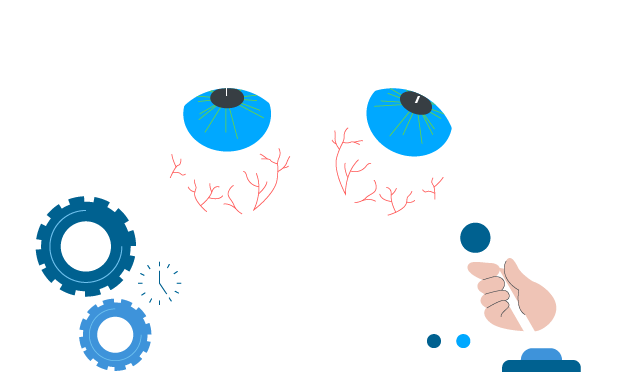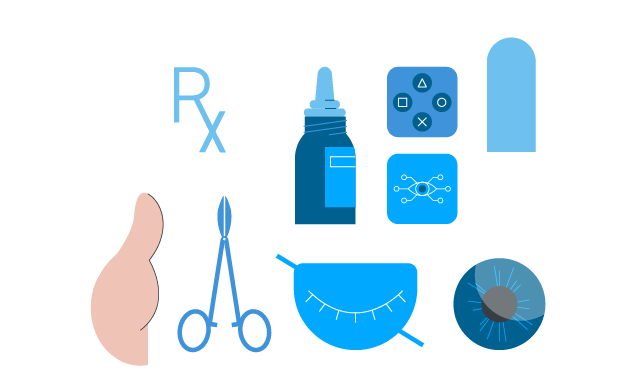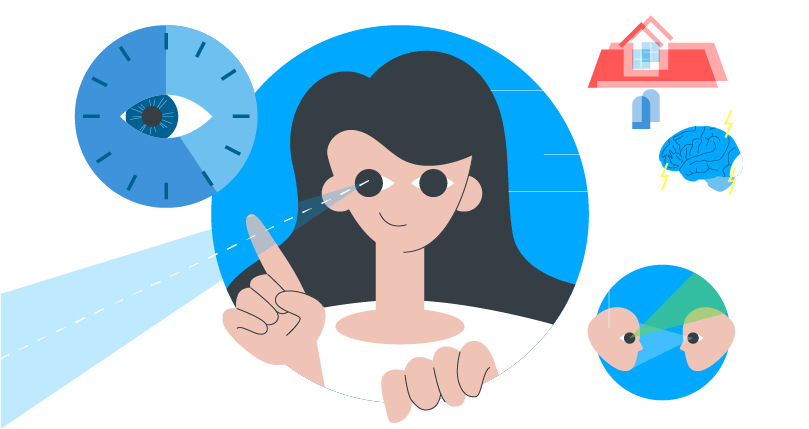I'm suffering from strabismus since I was born. [1]
While my strabismus was present at birth [2] , due to regular vision training it turned into an very mild intermittent/transient form of strabismus.
For most people suffering from intermittent strabismus, the progression is exactly the opposite. They start with an intermittent form, then eventually the situation can deteriorate in serious strabismus as they lose more and more control of their eye muscles. [3]
In this article you'll learn how to prevent that deterioration and guarantee your long-term eye health - or that of your loved ones.
1.What Is Intermittent Strabismus?

Intermittent strabismus is not pure strabismus. In general, the person suffering from intermittent strabismus has some control over their eye position.
Intermittent strabismus is not pure strabismus. In general, the person suffering from intermittent strabismus has some control over their eye position.They can achieve fusion (in plain English this means: both eyes working together), but occasionally lose that ability and the eyes are often outward turning (become misaligned).
The control of the eyes can vary throughout the day [4], and is often influenced by factors such as stress or sleep deprivation.
1.1 What is the most common form of intermittent strabismus?
The most common form of intermittent strabismus is called 'intermittent exotropia'. [5]
1.2 How common is intermittent exotropia?
It affects as much as 1% of the population [6], and is typically not associated with an underlying systemic disease.
This condition most often presents in childhood. Some studies report it being twice as common in females than in males. [7]
1.3 What causes intermittent exotropia?
Transient (e.g. short-term) misalignment of a baby’s eyes is very common up to the age of four months.
Intermittent exotropia most commonly develops between the ages of 10 months and four years, and can be rather difficult to detect. [8]
The most common cause of intermittent exotropia is a lack of muscle control in the eye muscles, which can be caused by a variety of factors, including genetics, neurological conditions, and problems with the development of the eye muscles.
Other possible causes of intermittent exotropia include trauma, inflammation, and certain medications. In some cases, the cause of intermittent exotropia is unknown.
1.4 What are the most common symptoms of transient exotropia?
A classic symptom of intermittent exotropia is the closure of one eye in bright sunlight, or bright light in general. [9]
In children, parents are often unable to describe accurately the abnormality that they see. And will often say that the eye looks ‘funny’ or ‘glassy’. [10]
1.5 What are other, less common symptoms of transient exotropia?
- Double vision (diplopia): This is the most common symptom of transient exotropia, and occurs when the brain receives two slightly different images from the eyes. Some people with transient exotropia may tilt their head to one side in an attempt to alleviate their double vision.
- Difficulty maintaining eye contact: People with transient exotropia may have difficulty maintaining eye contact with others, as their eyes may drift outward.
- Difficulty reading (blurry vision): Transient exotropia can also make it difficult to read, as the eyes may not be able to work together to focus on the same line of text.
- Eyestrain (due to poor vision/fusion): Transient exotropia can also cause eyestrain and fatigue, as the eyes are constantly working hard to try to maintain proper alignment.
- Squinting: Some people with transient exotropia may squint in an attempt to alleviate their double vision.
- Lack of depth perception: As common in most forms of strabismus, people with transient strabismus do not have as good of a sense of depth as 'normal' people.
- Headaches: Transient exotropia can also cause headaches, as the eyes are constantly working hard to try to prevent crossed eyes.
1.6 Can intermittent exotropia cause permanent vision loss?
Intermittent exotropia can potentially cause permanent vision loss if it is not treated.
When the eyes are not aligned properly, it can cause the brain to receive two different images, which can lead to double vision and confusion. If left untreated, intermittent exotropia can worsen into strabismus - and eventually it can lead to amblyopia. [11]
Amblyopia is known as lazy eye, which can lead to permanent vision loss in the affected eye.
1.7 How is intermittent strabismus diagnosed?
Intermittent strabismus, also known as intermittent exotropia, is usually diagnosed through a comprehensive eye exam.
During the exam, the eye doctor will perform a number of tests to evaluate the alignment and function of the eyes. These tests may include:
- Cover test (Most common): The doctor will cover one eye and ask you to look at an object in the distance. The doctor will then uncover the covered eye and observe how the eyes move.
- Penlight test: The doctor will shine a light into your eyes and observe how the pupils respond.
- Ocular motility test: The doctor will observe your eyes as they move in different directions to determine if they are properly aligned.
- Visual acuity test: This test measures how well you can see letters or numbers on a chart from a distance.
Other tests, such as imaging studies or eye muscle function tests, may also be performed to help diagnose intermittent strabismus.
2. The 5 Best Treatment Options To Cure Intermittent Strabismus

In this section, we will discuss the various treatment options that are available for curing intermittent strabismus and provide tips on how to manage this condition effectively.
Whether you are considering eyeglasses, patches, or surgery, we will help you understand your options and make an informed decision about the best treatment for your needs.
I will also share my personal experience for you to make the best informed deicsion.
2.1 Corrective lenses (prism lenses): Correct refractive errors
The goal of corrective lenses is to correct any refractive errors (such as nearsightedness, farsightedness, or astigmatism) that may be contributing to the misalignment of the eyes.
This is the absolute fundament of proper strabismus therapy. By correcting these errors, the eyes are able to focus more accurately, which can help to reduce the frequency and severity of exotropia episodes
My personal experience: I didn't correct my vision error for a few years (I got amblyopia). As such, it started to worsen and I lost more and more eyesight. Correct your visual acuity as soon as possible.
2.2 Patching therapy: Improve visual acuity of weaker eye
The goal of patching therapy is to improve the visual acuity of the weaker eye and encourage the brain to use it more. This is typically done by covering the stronger eye with a patch or eyepatch, which forces the brain to rely on the weaker eye for vision.
Patching therapy may be recommended for children or adults with transient strabismus who have a significant difference in visual acuity between the two eyes.
My personal experience: Effective, but socially horrible. Everyone stares at you with a patched eye as an adult. As a result, I avoided going to supermarkets and stayed at home during most of my patching time.
2.3 Eye drops/ Atropine drops
Atropine drops are used to relax the eye muscles, which then dilate the pupils and create blurry vision.
It works similar to eye patching (it shuts off the dominant eye) - it just is socially more optimal.
It is important to note that eye drops are not a standalone treatment for transient strabismus and are usually used in combination with other treatment options, such as eyeglasses, patches, or surgery.
My personal experience: Effective, but weird. Makes daily activities such as driving almost impossible. Also, I've experienced some negative side effects such as drowsiness.
And if someone stares at you, you look like a drug-junkie (as one eye is dilated).
2.4 Eye muscle surgery: Adjust eye muscles
Eye muscle surgery, also known as strabismus surgery or eye muscle adjustment surgery, is a routine surgical treatment option that is sometimes used for treatment. [12]
Although surgery is the go-to treatment for normal strabismus, intermittent esotropia/exotropia is harder to correct with surgery. As the eye deviation (eye misalignment) is less steady throughout the day. [13]
My personal experience: Was personally not effective for me. I've got surgery in 2019. While it has improved the condition temporarily, over the long-term, I got back to the my previous status quo.

2.5 Vision therapy (Most recommended for transient strabismus)
Vision therapy, also known as visual training or eye exercises, is in my opinion the most recommend treatment for transient strabismus.
The goal of vision therapy is to improve eye muscle control and eye coordination, which can help to correct misalignment of the eyes and improve visual function. It can also prevent the condition from worsening into full-blown strabismus.
My personal experience: I've tried for most of 2019. As a result, I've improved my condition significantly. The only downside is it's crazy cost:
Developmental optometrists charge, on average, $152 per hour. This is either a $608, $304 or $152 monthly retainer. Non-included here is the VR headset, which cost $270 – and the monthly cost of the VR software which cost $99.
For children, that cost is definitely worth it. The best way to start is by scheduling a vision therapy appointment at an office of an optometrist or ophthalmologist, or in a specialized vision therapy center.
For adults, I'd recommend starting a free trial of our artificial intelligence software 'Lazyeyefix'. The software was developed by me - and leading AI developers - after being frustrated by the options available to treat strabismus in the comfort of one's home, and without a hefty price tag.
The lifetime cost of the software is less than one single consultation at a vision therapy center. And our data shows that it's very effective in helping improve control of your eyes, therefore improve the condition and prevent it from worsening.
You can download the software, and start a free trial, here.
References:
[1] Strabismus by Cleveland Clinic: https://my.clevelandclinic.org/health/diseases/15065-strabismus-crossed-eyes
[2] Born Too Soon - The Global Action Report on Preterm Birth by WHO: http://apps.who.int/iris/bitstream/handle/10665/44864/9789241503433_eng.pdf?sequence=1
[3] Clinical Strabismus Management: Principles and Surgical Techniques: https://www.semanticscholar.org/paper/Clinical-Strabismus-Management%3A-Principles-and-Sloper/297f8b8d49d4ce238b34942baa03a1342e6fbe23
[4] Variability of control in intermittent exotropia: https://pubmed.ncbi.nlm.nih.gov/17629562/
[5] Intermittent Exotropia by the American Academy of Opthalmology: https://www.aao.org/disease-review/intermittent-exotropia-2
[6] Intermittent Exotropia: https://pubmed.ncbi.nlm.nih.gov/11705139/
[7] Female predominance in intermittent exotropia: https://pubmed.ncbi.nlm.nih.gov/16139014/
[8] Cooper J, Medow N. Intermittent exotropia – Basic and divergence excess type: Major review. BIN Vision Eye Musc Quart 1993;8:185-216
[9] Monocular eye closure in sunlight: https://pubmed.ncbi.nlm.nih.gov/2324913/
[10] Common types of strabismus: https://www.ncbi.nlm.nih.gov/pmc/articles/PMC2830773/pdf/pch04533.pdf
[11] The Amblyopia Treatment Studies: Implications for Clinical Practice: https://www.ncbi.nlm.nih.gov/pmc/articles/PMC5396957/
[12] Surgery is a routine procedure: https://www.aao.org/eye-health/tips-prevention/lazy-eye-surgery-facts
[13] Human error in strabismus surgery: quantification with a sensitivity analysis: https://pubmed.ncbi.nlm.nih.gov/18953557/






